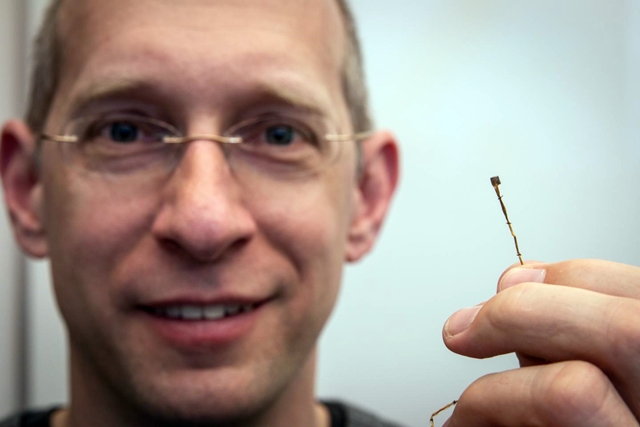
University of Utah engineering professor Florian Solzbacher holds a version of the Utah Electrode Array. (Dan Hixson, University of Utah)
20 Mar. 2019. An international group of universities and companies is designing a next-generation device to restore more natural hearing to people suffering from hearing loss. The 5-year initiative is funded by a $9.7 million grant from National Institute of Neurological Disorders and Stroke, part of National Institutes of Health.
According to National Institute on Deafness and Other Communication Disorders, or NIDCD, some 37.5 million or 15 percent of adults in the U.S. report at least some trouble hearing, with 2 to 3 of every 1,000 children born with detectable hearing loss in one or both ears. Since the 1980s, the standard of care for hearing loss is cochlear implants, electronic devices that restore some hearing by performing the functions of cochlear hair cells that convert sound waves into electrical nerve signals, sufficient to understand speech.
NIDCD says some 324,000 cochlear devices are implanted worldwide. These devices, however, have their limitations. Cochlear implants, for example, cannot restore more qualitative hearing abilities, such as differentiating musical tones, and discriminating among sounds in noisy environments. And for some individuals with hearing loss, the implants do not adequately fit the anatomical requirements of their cochlea, nor are able to transmit electrical signals across the bony cochlear wall to reach the auditory nerve.
The researchers led by biomedical engineering and otolaryngology professor Hubert Lim at University of Minnesota in Minneapolis plan to study an alternative to cochlear implants, an implant that directly connects to the auditory nerve. The team brings in physicians, engineers, and neuroscientists at University of Utah in Salt Lake City, Feinstein Institute for Medical Research in Manhasset, New York, and Hannover Medical School and International Neuroscience Institute in Hannover, Germany. The researchers also include participants from the company Blackrock Microsystems in Salt Lake City, and MED-EL, an auditory medical device developer in Innsbruck, Austria.
The first phase of the project aims to design and build a prototype auditory nerve implant that meets reliability, safety, functional, biocompatibility, and sterilization requirements for human use. The device aims to integrate an advance in neuroscience called the Utah Electrode Array, a tiny chip-like device developed at University of Utah and offered by Blackrock Microsystems, collaborators on the project. The original Utah array is implanted in the brain to record neural signals, but a newer variation is made to connect to peripheral nerves, such as the auditory nerve. Its developers say the array could be used in today’s cochlear implants.
“You have much higher resolution of sound, which means you can cover more individual frequencies and have better tonal range,” says Florian Solzbacher, University of Utah engineering professor, in a university statement. “That should allow you to get more realistic hearing.” Solzbacher is Utah’s lead investigator on the project and a co-founder of Blackrock Microsystems.
In the second phase of the project, during its last 2 years, the researchers plan to surgically implant the auditory nerve implant in up to 3 individuals with hearing loss, after preclinical tests with cadavers. The small clinical trial will test for the device’s safety and technical feasibility, and is expected to set the stage for further larger-scale trials and regulatory submissions.
“Work to develop brain or intracranial solutions beyond the cochlear implant is getting more attention in recent years,” says Lim in a University of Minnesota statement.” Lim adds, “We hope that our proposed auditory nerve implant could lead to a new generation of neural technologies and greatly advance novel treatment options in the hearing implant industry.”
More from Science & Enterprise:
- Foundation Studies Robotic Arm-Wrist Assist Device
- Fox Foundation Supports Parkinson’s Walking Device
- FDA Drafts Brain-Computer Device Regulatory Guidance
- Prosthetic Hand Gives Better Sense of Position, Movement
- Non-Invasive Brain Stimulation Adapted for Epilepsy
* * *

 RSS - Posts
RSS - Posts
You must be logged in to post a comment.